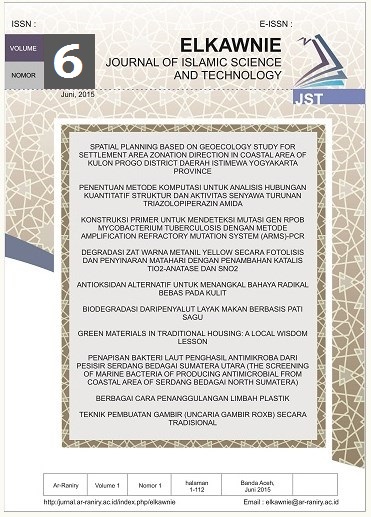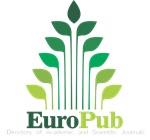Inhibition of α-Glucosidase Activity and The Toxicity of Tristaniopsis merguensis Griff. Leaf Extract
DOI:
https://doi.org/10.22373/ekw.v6i1.5732Keywords:
Inhibition of α-glucosidase, acetone extract, Tristaniopsis merguensis Griff., Brine Shrimp Lethality Test, BSLTAbstract
Abstract : This study aims to determine the antidiabetic activity and toxicity of the acetone extract of Tristaniopsis merguensis Griff leaf. The antidiabetic test was the α-glucosidase inhibition method, while the toxicity test used the Brine Shrimp Lethality Test (BSLT) method. The acetone extract possessed antidiabetic activity with an IC50 value of 8.83 ± 0.31 (μg/mL). This value is not much different from the positive control of quercetin which has an IC50 value of 6.04 ± 0.14 (μg/mL). The characteristics of the FT-IR spectrum of acetone extract showed that Tristaniopsis merguensis leaf has the groups Ar-OH (phenolic), -OH (hydroxyl), C=O (ketone) and C=C (aromatic). Based on the toxicity test, the Tristaniopsis merguensis leaf acetone extract has an LC50 value of 959.25 ppm which means that the acetone extract is toxic. Therefore, the acetone extract of Tristaniopsis merguensis might be the potential agent of antidiabetic.
Abstrak : Penelitian ini bertujuan untuk mengetahui aktivitas antidiabetes dan toksisitas dari ekstrak aseton daun Tristaniopsis merguensis Griff. Uji aktivitas antidiabetes ditentukan berdasarkan metode inhibisi enzim α-glucosidase, sedangkan toksisitas ditentukan berdasarkan metode Brine Shrimp Lethality Test (BSLT). Ekstrak aseton memiliki aktivitas antidiabetes dengan nilai IC50 8,83 ± 0,31 (μg/mL). Nilai ini tidak jauh berbeda dengan kontrol positif quersetin yang memiliki nilai IC50 6,04 ± 0,14 (μg/mL). Karakteristik spektrum FT-IR ekstrak aseton menunjukkan bahwa daun Tristaniopsis merguensis memiliki gugus fungsi Ar-OH (fenolik), -OH (hidroksil), C=O (keton) dan C=C (aromatik). Berdasarkan uji toksisitas, ekstrak aseton daun Tristaniopsis merguensis memiliki nilai LC50 sebesar 959,25 ppm yang berarti bahwa ekstrak aseton bersifat toksik. Oleh karena itu, ekstrak aseton dari Tristaniopsis merguensis berpotensi untuk dijadikan agen antidiabetes.
References
Ahmed, F., Jnns, C., & Nv, T. (2009). An In Vitro Study on the inhibitory Activities of Eugenia jambolana Seeds Against Carbohydrate Hydrolyzing Enzymes. J .Young Pharm., 1(4), 317–321. https://doi.org/10.4103/0975-1483.59320
Albuntana, A., Yasman, & Wardhana, W. (2011). Toxicity test of extracts of the four sea cucumber (Family holothuriidae) from East Penjaliran island, Seribu Islands, Jakarta based on the brine shrimp lethality test (BSLT). Jurnal Ilmu Dan Teknologi Kelautan Tropis, 3(1), 65–72.
Dewi, R. T., Tachibana, S., & Darmawan, A. (2013). Effect on a-glucosidase inhibition and antioxidant activities of butyrolactone derivatives from Aspergillus terreus MC751. Medicinal Chemistry Research, 23(1), 454–460. https://doi.org/10.1007/s00044-013-0659-4
Dhone, B. S., Cunha, T., & Darmakusuma, D. (2018). Uji toksisitas ekstrak karang lunak sarcophyton sp asal timor terhadap larva artemia salina leach. Chem. Notes, 1(1), 32–40.
Enggiwanto, S., Istiqomah, F., Daniati, K., Roanisca, O., & Mahardika, R. G. (2018). Ekstraksi daun pelawan ( Tristaniopsis merguensis ) sebagai antioksidan menggunakan Microwave Assisted Extraction ( MAE ). Indonesian Journal of Pure and Applied Chemistry, 1(2), 50–55.
Feng, J. Y.-W. (2011). Bio-assay guided isolation and identification alpha-glucosidase inhibitors from the leaves of Aqualaria sinensis. Phytochemistry, 72, 242-247.
Goa, H. H. (2008). a-Glucosidase inhibitory effect by the flower buds of Tussilago farfara L. Food Chemistry, 106, 1195-1201.
Kahn, C. R. (1996). Genetics of non-insulin-dependent (type-II) diabetes mellitus. Annu. Rev. Med., 104, 509-31.
Khuankaew, S. S. (2014). Ethnobotanical study of medicinal plants used by Tai Yai in Northern Thailand. Journal of Ethnopharmacology, 151, 829-938.
Kumar, S. N. (2011). Alpha-glukosidase inhibitors from plants: A natural approach to treat diabetes. Pharmacognosy Reviews, 5, 19-29.
Mahardika, R. G., & Roanisca, O. (2018). Antioxidant activity and phytochemical of extract ethyl acetate pucuk idat (Cratoxylum glaucum ). Indo. J. Chem. Res, 5(2), 481–486.
Mahardika, R. G., & Roanisca, O. (2019). Microwave-Assisted Extraction of polyphenol content from Leaves of Tristaniopsis merguensis. ASEAN Journal of Chemical Engineering, 19(2), 110–119. https://doi.org/10.22146/ajche.50448
Maobe, M. A. G., Nyarango, R. M., & Box, P. O. (2013). Fourier Transformer Infra-Red Spectrophotometer Analysis of Urtica dioica Medicinal Herb Used for the Treatment of Diabetes, Malaria and Pneumonia in Kisii Region, Southwest Kenya. World Applied Sciences Journal, 21(8), 1128–1135. https://doi.org/10.5829/idosi.wasj.2013.21.8.2876
Ningdyah, A. W., Alimuddin, A. H., & Jayuska, A. (2015). Uji toksisitas dengan metode BSLT ( Brine Shrimp Lethality Test ) terhadap hasil fraksinasi ekstrak kulit buah tampoi. Jurnal Kimia Katulistiwa, 4(1), 75–83.
Nkobole, N., Houghton, P. J., Hussein, A., & Lall, N. (2011). Antidiabetic Activity of Terminalia sericea Constituents. Natural Product Communications, 6(11), 1585–1588. https://doi.org/10.1177/1934578X1100601106
Purwakusumah, E. D., Rafi, M., Syafitri, U. D., Nurcholis, W., Agung, M., & Adzkiya, Z. (2014). Identification and Authentication of Jahe Merah Using Combination of FTIR Spectrocopy and Chemometrics. AGRITECH, 34(1), 82–87.
Roanisca, O., Mahardika, R. G., & Sari, F. I. P. (2019). Total Phenolic and Antioxidant Capacity of Acetone Extract of Tristaniopsis meguensis Leaves. Stannum : Jurnal Sains Dan Terapan Kimia, 1(1), 10–13.
Roanisca, O., Mahardika, R. G., & Setiawan, Y. (2019). Tristaniopsis merguensis Griff. Extract as Inhibitor for Corrosion of Stainless Steel IOP Conference Series: Earth and Environmental Science, 353 012020. https://doi.org/10.1088/1755-1315/353/1/012020
Saraswaty, V. (2010). Alpha Glucosidase Inhibitory Activity From Syzigium sp. Teknologi Indonesia, 33(1), 33–37.
Sari, A. N., Kusdianti, & Diningrat, S. D. (2018). Analisis Gc-Ms Senyawa Bioaktif Pencegah Penyakit Degeneratif Dari Ekstrak Etanol Kulit Buah Jamblang (Syzygium cumini). Elkawnie: Journal of Islamic Science and Technology, 4(2), 1–14. https://doi.org/10.22373/ekw.v4i2.4143
Sun, W., Sang, Y., Zhang, B., Yu, X., Xu, Q., Xiu, Z., & Dong, Y. (2017). Synergistic effects of acarbose and an Oroxylum indicum seed extract in streptozotocin and high-fat-diet induced prediabetic mice. Biomedicine et Pharmacotherapy, 87, 160–170. https://doi.org/10.1016/j.biopha.2016.12.096
Swantara, I. M. D., Rita, W. S., Made, I., & Suardhyana, A. (2016). Toksisitas senyawa flavonoid dari ekstrak etanol daun dewandaru (Eugenia uniflora Linn.) Sebagai skrining awal antikanker. Jurnal Kimia, 10(2), 181–189.
Verotta, L., Agli, M. D., Giolito, A., Guerrini, M., Cabalion, P., & Bosisio, E. (2001). In Vitro Antiplasmodial Activity of Extracts of Tristaniopsis Species and Identification of the Active Constituents : Ellagic Acid and 3 , 4 , 5-Trimethoxyphenyl- ( 6 ′ - O -galloyl ) - O - - D -glucopyranoside. Journal of Natural ProductNatural Product, 64(5), 603–607.
Downloads
Additional Files
Published
Issue
Section
License
Proposed Policy for Journals That Offer Open Access Authors who publish with the Elkawnie journal agree to the following terms:
a. Authors retain copyright and grant the journal right of first publication with the work simultaneously licensed under a Creative Commons Attribution License that allows others to share the work with an acknowledgement of the work's authorship and initial publication in this journal.
b. Authors are able to enter into separate, additional contractual arrangements for the non-exclusive distribution of the journal's published version of the work (e.g., post it to an institutional repository or publish it in a book), with an acknowledgement of its initial publication in this journal.
c. Authors are permitted and encouraged to post their work online (e.g., in institutional repositories or on their website) prior to and during the submission process, as it can lead to productive exchanges, as well as earlier and greater citation of published work (see The Effect of Open Access).

























